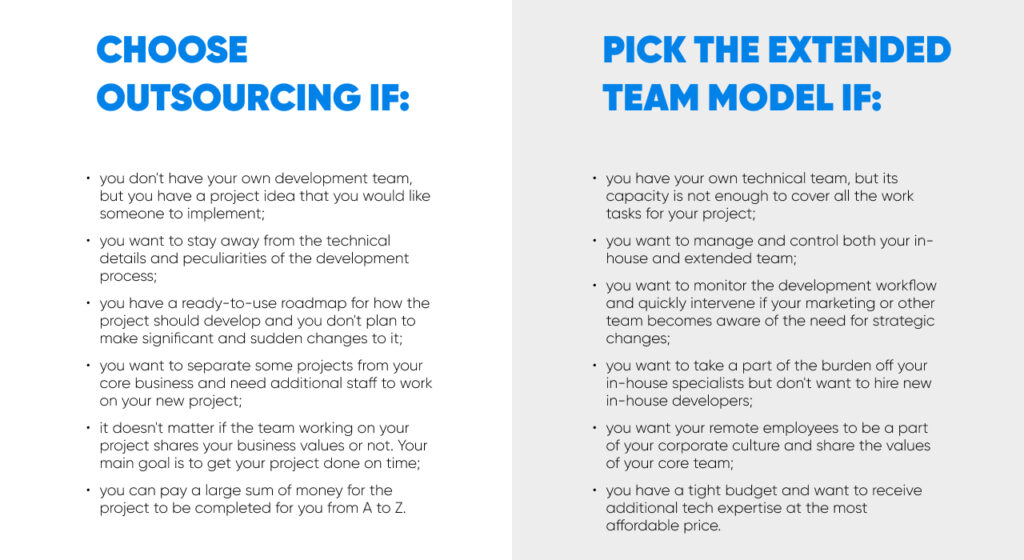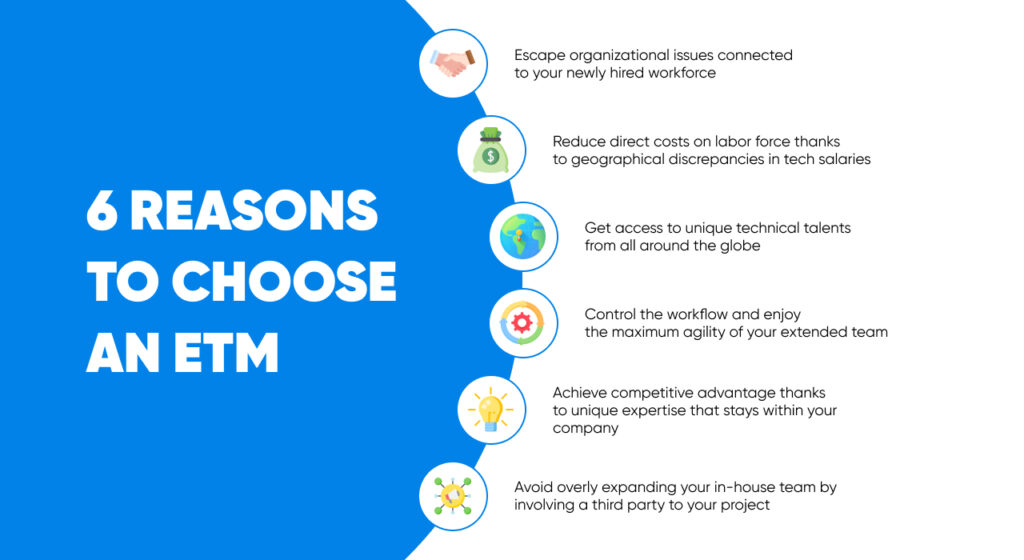
Fixed-bid outsourcing is not always the best way to delegate IT services. The extended team model is another business cooperation method that is particularly widely spread in the field of software development. Why so? What are its benefits and peculiarities and, more importantly, should your business opt for ETM? Let’s find it out!
Contents:
- Extended team model definition
- Why should you opt for ETM instead of traditional outsourcing?
- Is the extended team model better than outsourcing?
- The benefits of ETM for the business
- Why do developers prefer working with IT outstaffing companies?
- Can an extended team help you with strategic planning and top management?
- How do you manage the core team and extended team?
- Summing up
EXTENDED TEAM MODEL DEFINITION
The extended team model is a cooperation method that allows businesses to headhunt and hire employees without the de jure expansion of the company’s workforce. This “trick” is possible as such new teammates remain the employees of the IT vendor. In other words, although new employees reinforce your in-house team with their skills and expertise, all the organizational issues concerning their hiring, onboarding, insurance, paychecks, vacations, sick leaves, and technical support are on behalf of your IT vendor.
The extended team model is also often referred to as staff augmentation because with the help of such a team you increase your staff expertise. An extended team of new employees works remotely and is often located in another country, sometimes even on another continent.
Why should you opt for ETM instead of traditional outsourcing?
While having many advantages of traditional outsourcing, the extended development team model doesn’t have the weak points of outsourcing.
- You don’t have to pay a fortune for software development. In contrast with fixed-bid outsourcing, ETM is considered one of the most affordable ways to obtain IT services.
- You get stronger security and non-disclosure guarantees. All the research conducted, code written, and innovations invented will at all times stay the intellectual property of your company (unless otherwise agreed in the contract).
- You stay agile and can amend requirements to the final version of your project depending on the newly discovered analysis or client testing.
- You retain maximum control over new employees. You set their tasks, monitor their performance, and promptly manage and direct their work.
IS THE EXTENDED TEAM MODEL BETTER THAN OUTSOURCING?
Outsourcing and the extended team model are not exact synonyms or direct competitors, they’re both good for certain business cases. Check out some examples of when it is worth choosing fixed-bid outsourcing, and when it is better to opt for staff augmentation.

When you outsource a startup, you usually hire the entire team that will deal with your project: a UI/UX designer, a marketing specialist, several developers, QA engineers, and a product manager.
In the case of the extended team model, you can hire specific talents for your current needs. This means, in particular, that when you come to an IT vendor, you must clearly formulate your request – what kind of specialist your team lacks at the moment. If you’re not sure whom exactly you need, contact us and our specialists will help you sort this out.
THE BENEFITS OF ETM for the business
The extended team model has many benefits for both businesses and developers. Let’s start with the business:

1. Escape organizational issues.
Since de jure the members of your extended team remain employees of your IT vendor, all legal, accounting, and HR issues (taxes, salaries, sick leaves and vacations, insurance, material provision of technical means) are handled by the contracting company, not you.
2. Reduce costs.
If your new employees live in countries where the salary level is lower than in the one in which you are located, you can save from 15% to 50% on direct labor costs without losing in quality of development.
3. Access the global pool of talents.
If you are looking for a developer to work in your physical office, then your choice is limited to only those people who are geographically situated in your city. In order to access a wider pool of technical experts, sometimes it is worth going beyond your country’s borders.
4. Enjoy agility.
Unlike outsourcing, in which you delegate the entire project including managerial tasks to a contractor, with the classic extended team model, product managers, and delivery managers remain in your core team. That is, your employees have full control over the scope of tasks performed by new team members and can promptly intervene if the market situation demands some amendments to the project’s roadmap.
5. Remain control over all intellectual property.
By working closely with your core team, new developers will share their experience and knowledge, and all their developments and workings will remain the intellectual property of your company.
6. Avoid overly expanding your in-house team.
The extended team model is very often used to cover the need for specialists during the peak load on the main team. Let’s say your application has an update once a year and you need to test a lot of new features in a short period of time. Instead of hiring a new QA engineer whom you will need only for one month, you can delegate part of the quality assurance tasks to the extended team and terminate your cooperation as soon as you stop needing their assistance.
Why do developers prefer working with IT outstaffing companies?
The extended team model provides a number of advantages for the developers.
Relatively high salaries.
For example, if we are talking about the Ukrainian IT market, according to specialized tech platforms, outstaffing companies (that is, companies that provide extended team services) offer their tech talents the highest salaries. Outsourcing companies come next by the level of remuneration and only in third place are national product companies.

Great involvement in the project.
By working directly with business owners, developers have a better chance of influencing the features and the overall look of the final project. They can share their rationalization proposals and they will be heard and appreciated.

Work with specialists from different countries.
The outstaffing developers get the opportunity to expand their professional circle of acquaintances and learn from experts in their field but with different backgrounds. Most often, when developers from different countries meet, they can teach each other a lot.
Generally speaking, working by the extended team model is beneficial for both business owners and developers. But does ETM suits all business needs?

CAN AN EXTENDED TEAM HELP YOU WITH STRATEGIC PLANNING AND TOP MANAGEMENT?
The additional experience and expertise of unique specialists are one of the reasons why companies turn to the extended team model. Along with the help of ordinary technical specialists, companies often need assistance with making strategically important decisions that will affect the future of the project. Such professional assistance can be obtained through the extended leadership team. The ELT purpose is to expand your expertise with the help of advisors and counselors.
The request for this type of service often arises when you are about to enter the international market and need advice on how best to do so in a particular country.
Hiring an extended leadership team will also help you look at your product from different angles. Just think of it: if your board of directors consists of ten men in their 40s who live in New York, with technical education, you can consider that your board of directors consists of only one person – a 40-year-old New Yorker with technical education. Because of the one-sided life experience, he may not see the opportunities that specialists in other fields and from other countries will point out.
By choosing the extended leadership team model, you get access to the experience and knowledge of a wide variety of people who will help you manage your project and make strategically important decisions.
HOW DO YOU MANAGE THE CORE TEAM AND EXTENDED TEAM?
Many companies and managers struggled when we all went remote at the beginning of 2020. Working with an online team is different than managing a team that you see every day. Organizing an efficient workflow within a team that partially consists of the core office and partially of remote employees, who may live in another country, can be even more challenging. Here are some tips on how to get the most out of the extended team model.
- Designate the hours when your remote employees should be available to resolve work issues. This is especially important if you use the services of an offshore extended team and the time zone of your new coworkers differs from the time zone where your head office is situated.
- Motivate your core and extended team to communicate. It has been proven that people with good friendly relations tend to perform work tasks more efficiently, as they don’t want to “set up their teammate.”
- Start working meetings with a few minutes of small talk with your team. Be interested in your new employees, ask them questions, and involve them in the discussion of work issues.
- Change the project or the scope of your developers’ tasks from time to time. How often should development team membership change? It is believed that for the greatest efficiency, you should not keep a developer on one project or in one position for more than 12-18 months. After this period, the developer’s interest in the project often wanes, and work decisions become automated and devoid of creativity. Take care of your employees’ motivation either by moving them up the career ladder or by offering them new projects.
SUMMING UP
The extended team model is an extremely convenient and profitable way to expand the expertise of your team without increasing the workforce. With this model, you get a team of dedicated developers who share your principles and values and are also able to reduce the burden on your core team members.
With the ETM, you can hire not only developers but also top managers who can help you with making strategic decisions.
The extended team model is for you if you need a more agile team able to respond to sudden changes in your project’s development strategy. If you want to keep away from technical issues and completely delegate the implementation of your project to a contractor, it is better to choose an IT vendor with a fixed bid.
MWDN has a huge experience in augmenting staff and hiring tech talents that will best suit your business needs. We have vast expertise in healthcare, the financial sphere, logistics, production, and telecommunication.
Content
- 1 EXTENDED TEAM MODEL DEFINITION
- 2 Why should you opt for ETM instead of traditional outsourcing?
- 3 IS THE EXTENDED TEAM MODEL BETTER THAN OUTSOURCING?
- 4 THE BENEFITS OF ETM for the business
- 5 Why do developers prefer working with IT outstaffing companies?
- 6 CAN AN EXTENDED TEAM HELP YOU WITH STRATEGIC PLANNING AND TOP MANAGEMENT?
- 7 HOW DO YOU MANAGE THE CORE TEAM AND EXTENDED TEAM?
- 8 SUMMING UP